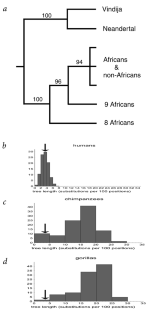A view of Neandertal genetic diversity (original) (raw)
- Brief Communication
- Published: October 2000
- Cristian Capelli2 na1,
- Frank Tschentscher na1 nAff3,
- Helga Geisert4,
- Sonja Meyer1,
- Arndt von Haeseler1,
- Karl Grossschmidt5,
- Göran Possnert6,
- Maja Paunovic7 &
- …
- Svante Pääbo1
Nature Genetics volume 26, pages 144–146 (2000)Cite this article
- 2083 Accesses
- 278 Citations
- 12 Altmetric
- Metrics details
The retrieval of mitochondrial DNA (mtDNA) sequences from the Neandertal type specimen from Feldhofer Cave in western Germany1,2 made possible a comparison of DNA sequences from an extinct hominid with those from modern humans. Recently, a second mtDNA sequence from a Neandertal child found in Mezmaiskaya Cave in the northern Caucasus was determined and found to be similar to the type specimen3. To further study the Neandertal mtDNA gene pool, we analysed the amino acid composition and extent of amino acid racemization in 15 Neandertal bones found in the G3 layer4,5 in Vindija Cave, Croatia.
Seven samples proved to have a high content of amino acids, an amino acid composition similar to that of contemporary bone, and a low level of racemization of aspartic acid, alanine and leucine6, all features compatible with DNA preservation7. We dated one of the samples (Vi-75-G3/h-203; ref. 5) by accelerator mass spectroscopy to over 42,000 years before present (Ua-13873) and used it for five DNA extractions. In three of the extractions, we included N-phenacylthiazolium bromide (PTB), a compound that has been shown to improve DNA retrieval from late Pleistocene coprolites, probably due to its ability to cleave sugar-derived condensation products in which DNA may be entrapped8.
This is a preview of subscription content, access via your institution
Access options
Subscribe to this journal
Receive 12 print issues and online access
$209.00 per year
only $17.42 per issue
Buy this article
- Purchase on SpringerLink
- Instant access to full article PDF
Prices may be subject to local taxes which are calculated during checkout
Additional access options:
Figure 1: Schematic phylogenetic tree of 2 Neandertal mtDNA and 663 contemporary humans

References
- Krings, M. et al. Cell 90, 19–30 (1997).
Article CAS Google Scholar - Krings, M., Geisert, H., Schmitz, R.W., Kraininzki, H. & Pääbo, S. Proc. Natl Acad. Sci. USA 96, 5581–5585 (1999).
Article CAS Google Scholar - Ovchinnikov, I.V. et al. Nature 404, 490–493 (2000).
Article CAS Google Scholar - Wolpoff, H.M., Smith, H.F., Malez, M., Radovcic, J. & Rukavina, D. Am. J. Phys. Anthropol. 54, 499–545 (1981).
Article Google Scholar - Malez, M. & Ullrich, H. Palaeont. Jugosl. 29, 1–44 (1982).
Google Scholar - Krings, M., Serre, D., Paunovic, M. & Pääbo, S. in The Vindija Neandertals: Catalogue of Skeletal Remains (eds Rabeder, G., Paunovic, M. & Grossschmidt, K.) (Austrian Academy of Sciences & Croatian Academy of Sciences and Arts, Vienna-Zagreb, in press).
- Poinar, H.N., Höss, M., Bada, J.L. & Pääbo, S. Science 272, 864–866 (1996).
Article CAS Google Scholar - Poinar, H.N. et al. Science 281, 402–406 (1998).
Article CAS Google Scholar - Nordborg, M. Am. J. Hum. Genet. 63, 1237–1240 (1998).
Article CAS Google Scholar - Saunders, I.W., Tavaré, S. & Watterson, G.A. Adv. Appl. Probability 16, 471–491 (1984).
Article Google Scholar - Burckhardt, F., von Haeseler, A. & Meyer, S. Nucleic Acids Res. 27, 138–142 (1999).
Article CAS Google Scholar - Jorde, L.B., Bamshad, M. & Rogers, A.R. Bioessays 20, 126–136 (1998).
Article CAS Google Scholar - Strimmer, K. & von Haeseler, A. Proc. Natl Acad. Sci. USA 94, 6815–6819 (1997).
Article CAS Google Scholar - Anderson, S. et al. Nature 290, 457–465 (1981).
Article CAS Google Scholar
Acknowledgements
We thank H. Poinar for discussions and synthesis of PTB; C. Färber and S. Gross for technical support; W. Schartau for primer synthesis; J. Bark and P. Gill for experimental help; K. Strimmer and F. Burckhardt for help with databases and computer programs; A. Greenwood, J. Hey, S. Hornung, M. Stoneking, L. Vigilant and D. Serre for help and discussions; and the Deutsche Forschungsgemeinschaft and the Max Planck Gesellschaft for financial support.
Author information
Author notes
- Frank Tschentscher
Present address: Institute for Human Genetics, University Clinic, Essen, Germany - Matthias Krings, Cristian Capelli and Frank Tschentscher: These authors contributed equally to this work.
Authors and Affiliations
- Max Planck Institute for Evolutionary Anthropology, Leipzig, Germany
Matthias Krings, Sonja Meyer, Arndt von Haeseler & Svante Pääbo - Institute of Legal Medicine, Catholic University of S. Cuore, Rome, Italy
Cristian Capelli - Institute of Zoology, University of Munich, Munich, Germany
Helga Geisert - Institute for Histology and Embryology, University of Vienna, Vienna, Austria
Karl Grossschmidt - Division of Ion Physics, Ångström Laboratory, P.O. Box 534, Uppsala, Sweden
Göran Possnert - Institute of Quaternary Paleontology and Geology of the Croatian Academy of Sciences and Arts, A. Kovacica 5/II, Zagreb, Croatia
Maja Paunovic
Authors
- Matthias Krings
- Cristian Capelli
- Frank Tschentscher
- Helga Geisert
- Sonja Meyer
- Arndt von Haeseler
- Karl Grossschmidt
- Göran Possnert
- Maja Paunovic
- Svante Pääbo
Corresponding author
Correspondence toSvante Pääbo.
Supplementary information
Rights and permissions
About this article
Cite this article
Krings, M., Capelli, C., Tschentscher, F. et al. A view of Neandertal genetic diversity.Nat Genet 26, 144–146 (2000). https://doi.org/10.1038/79855
- Issue Date: October 2000
- DOI: https://doi.org/10.1038/79855